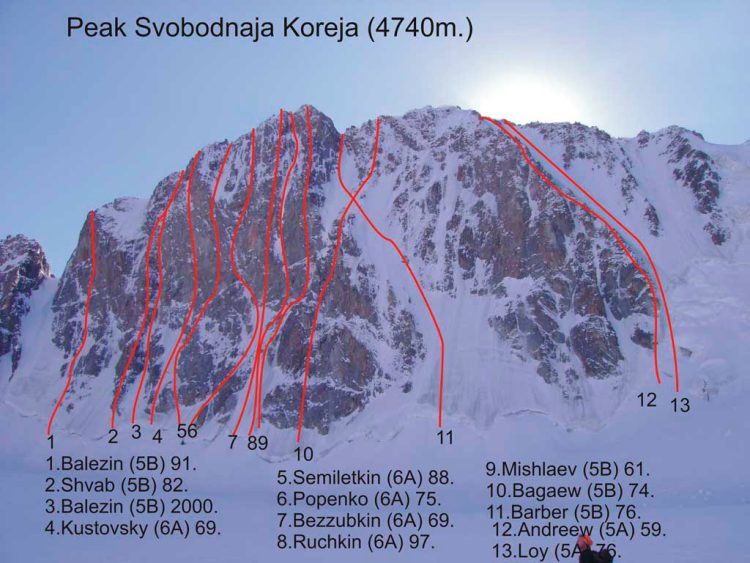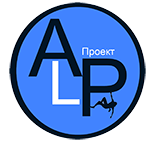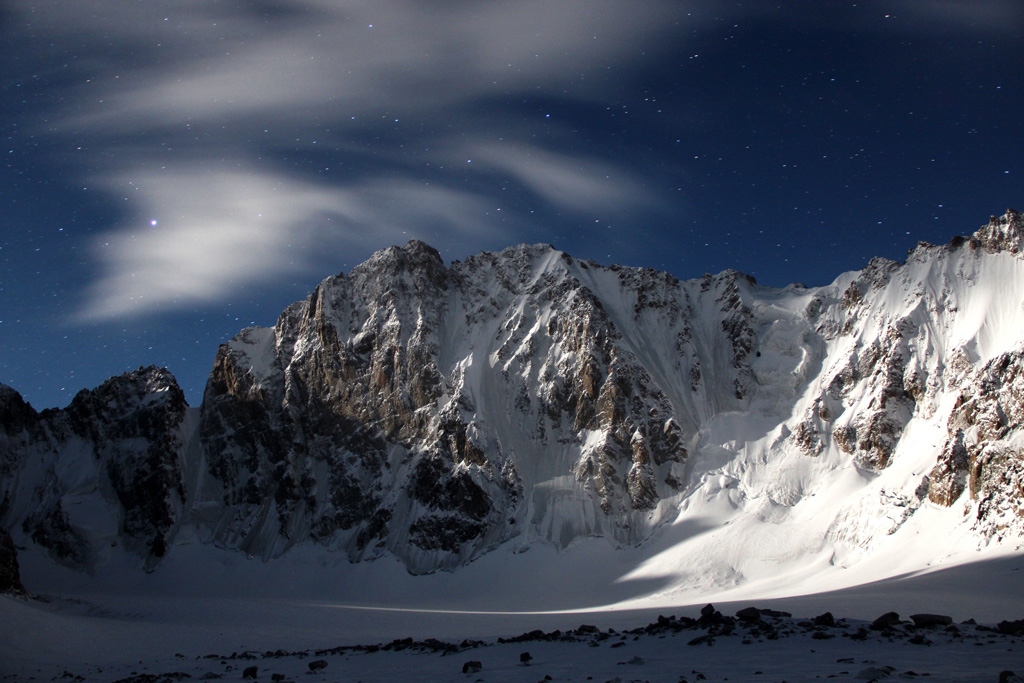Free Korea Peak is one of the most famous peaks of the former Soviet Union. Before the discovery of the 4810 peaks (Odessa Peak) in Karavshin and Ak-Su Peak in the late 80s, Korea, along with the Caucasian peaks Ushba and Chatyn, were considered the most difficult and prestigious technical-class peaks. They were used to climb the most routes, which were awarded gold medals at the Union championships.
Free Korea Peak is located in the Tien Shan in the Kyrgyz Range, near Bishkek (Frunze) in the Ala-Archa Gorge. This is the closest, especially for Krasnoyarsk residents, of the famous mountains (in terms of approaches): from Bishkek to the alpine camp 40 km along a good road, and the approach to the northern wall of Korea along the trail takes about 6 hours. But despite this, the northern wall of Korea remained untouched for a long time until 1959.
The height of Svobodnaya Korea is 4777 m. The difference in height from the bergschrund to the ridge is about 650 m. The level of the glacier under the wall is about 4000 m. The wall consists of three parts vertically: an icy bottom, a steep rocky middle part and a snowy, icy “roof”. The average steepness of the northern wall is about 65 degrees.
The weather in the area is very unstable, most often in the afternoon it starts raining or snowing, and since the wall is practically not illuminated by the sun, the northern wall of Korea is almost always icy and covered with snow. The wall is rock-hazardous, the terrain is heavily destroyed in places, there are many “live” rocks.
Climbing the routes requires a certain tactic, taking into account the rock hazard and unstable weather in the area. The descent from the summit is also difficult: you can go down to the south along route 4B to the Top-Karagay gorge, but it takes a long time to get out of it, so most groups prefer to go down to the north along the Low route.

The first ascent from the north to Korea was made in 1959 by a group led by Andreev (along the NW wall of the V ridge, 5A category). The route goes along a rocky ridge (see the map). Nowadays, Andreev’s route is rarely visited.
In 1961, a team led by Lev Myshlyaev, the strongest climber of his time, laid a route of 5B category and became the USSR champion in the technical class. The route goes along the right side of the northern wall and goes straight to the summit. Like all of Myshlyaev’s routes, it is one of the most logical and beautiful on the wall. In 1986, the Ukrainian team, having repeated Myshlyaev’s route, also became the USSR champion. So Myshlyaev route is twice gold.
The next successful attempt was made 5 years later, in 1966, the team from Alma-Ata led by Boris Studenin passed the route of 6A category, along the left part of the wall with an exit to the eastern ridge and also became champions of the USSR. Until now, no one has repeated their route.
And in 1969 two teams at once set out to storm the northern wall of Korea, these are the team from Krasnoyarsk led by Valery Bezzubkin: Yuri Andreev, Vladislav Lyakh, Viktor Sukhanov, Vladimir Ushakov and the team of Ukrainians led by A. Kustovsky. The route of the Krasnoyarsk team goes along the center of the wall and comes out slightly to the left of the summit. Currently, this is the most popular route, and in my opinion, it is the most beautiful and logical route on the wall. The ascent lasted eight days, steep, in places heavily destroyed rocks, covered with ice and sprinkled with snow, there are no ledges suitable for normal overnight stays on the wall, overnight stays are mainly sitting, but, despite all the difficulties, the team successfully completed the route and won gold medals at the USSR Championship in the technical class. The Ukrainian team, also, despite the complexity of the route and bad weather, completed its route in 10 days and took second place in the USSR Championship. Kustovsky’s route goes along the left side of the wall, and essentially straightens Studenin’s route, the bottom and top coincide with Studenin’s route, and the main wall part goes to the right along a very steep wall. In terms of complexity, it is not inferior to Bezzubkin’s route, and may even surpass it. The route has not been repeated to this day. Both routes are 6A category.
In 1974 a team of Krasnoyarsk residents led by Boris Bagayev:Valery Bezzubkin, Vladimir Kokorev, Vladimir Milko, Vitaly Paramonov passed the route 5B along the “triangle” From st. 16 years it stood unrepeated, and in 1991 in the winter, two teams passed it at once, winning silver and bronze medals in the USSR championship in the winter class, the second place was taken by the team from Krasnoyarsk (leader – V. Balezin), and the third – the team of the Ala-Archa alpine camp (leader – A. Agafonov).
In 1975 the team led by Yu. Popenko stormed the central part of the wall. They successfully passed it and took second place in the USSR championship. The route is to the left of the Bezzubkin route and is somewhat easier, mainly due to the large number of bolts driven into the key section at the top of the wall. In 1991, a team of Muscovites won gold medals at the USSR Winter Championship for completing this route. The Popenko route is 6A category, one of the most popular on the wall.
In 1976, a training camp of our strongest and American climbers was held in the Ak-Sai gorge. The Americans were especially strong on ice terrain, significantly stronger than us. This was explained by the use of the latest ice equipment for that time. Two Americans soloed (i.e. alone!) two ice routes along the couloirs of the northern wall. Barber climbed (5B) along a wide couloir that starts to the right of the Bagayev triangle, then crossed Bagayev’s route and came out on a col just to the right of the summit. And Lowe climbed (5A) along an ice couloir on the northwest wall, just to the right of Andreyev’s route. The Barber and Lowe routes are very popular at the moment.
In 1982 the team of the Ala-Archa alpine camp led by A. Schwab climbed a beautiful, logical and perhaps the safest route on the wall, but since the ascent was made outside of competition, it was classified as 5B (although in fact it corresponds to 6A), since then no one has wanted to repeat it. It passes on the left part of the wall along a clearly defined buttress.
In 1988 a team of Leningraders led by S. Semiletkin passed the most difficult route on the wall, for which they received silver medals of the USSR Championship. The route passes between the Popenko and Kustovsky routes. This is the most famous route in Korea, since after that it became gold three more times at the national championship in winter classes: in 1992 (team of Alma-Ata), in 1995 (team of Krasnoyarsk led by V. Balezin) and in 1996 (team of Yekaterinburg). No other mountaineering route in all the mountainous regions of the former USSR has such a set of medals (three gold and one silver). The route was classified as 6B for 10 years, and since 1998 it has been downgraded to 6A.
In 1991 in the summer, a team of Krasnoyarsk residents: leaders – Valery Balezin, Nikolay Zakharov, Petr Kuznetsov, Vyacheslav Savelyev, in bad weather conditions, but in just 3 days, for the first time passed the left “triangle” of the northern wall. This is the steepest part of the northern wall. During the passage of the upper part of the wall, it snowed heavily all day, but not a single snowflake fell on the route, since the wall had a negative slope. The route comes out on the eastern ridge in its leftmost part. In terms of the drop to the ridge, this is the shortest route, but it is the steepest and safest, and in terms of difficulty, I think it is not inferior to the Semiletkin route, despite the fact that, for some unknown reason, it is classified as 5B category, probably because it was completed outside the framework of the competition. The route has not been repeated and I think that as 5B it is unlikely that anyone will repeat it.
In the winter of 1994, the Krasnoyarsk team: leader. – Valery Balezin, Nikolay Zakharov, Valery Kokhanov, Konstantin Obednin, Alexey Gulyaev laid another route of 5B category, having climbed the steep rocky northwestern bastion and becoming the silver medalist of the national championship in the winter class.
It seemed that there was no more room on the wall for new routes, but due to the fact that ice technology has been rapidly developing lately, climbers began to go difficult steep ice routes. In the winter of 1997 the pair: A. Ruchkin, A. Puchinin passed a beautiful route (6A category, winter, 85% ice) along a very steep narrow couloir on the right side of the northern wall, between the routes of Bezzubkin and Myshlyaev and received bronze medals for it. And in 2000, in February the Krasnoyarsk Territory team: leaders – Valery Balezin, Vladimir Alexandrov, Andrey Zakrepa, Yuri Stepanov, Alexander Terentyev, Sergey Cherezov passed another similar route, but on the left side of the wall, between the Shvab and Studenin routes, and receivedwhether silver medals of the Russian championship in the winter class were won for it. For some reason, the route is classified as 5B (winter), although in fact it corresponds to 6A (z). These routes can only be used in winter, as they are very dangerous due to rocks in summer.
In addition, in November 1999, a team from Bishkek led by M. Mikhailov made a version of Semiletkin’s route, going through the middle part of his route to the left and thus straightening it.
I think that the story does not end here, and medals will be won more than once on the North Face of Korea at national championships in the winter climbing class.
Rating of routes by difficulty on a four-point system (according to Balezin):
| 1. | Semiletkin, 1988 |
6A
|
3.7 |
|||||||||||||||||||||||||||||||||||||||||||||||||||||||
| 2. | Balesin 91 |
5B |
3,6 |
|||||||||||||||||||||||||||||||||||||||||||||||||||||||
| 3. | Kustovsky |
6A |
3,4 |
|||||||||||||||||||||||||||||||||||||||||||||||||||||||
| 4. | Bezzubkin, 1969 |
6A
|
3,4 |
|||||||||||||||||||||||||||||||||||||||||||||||||||||||
| 5. | Popenko |
6A |
3,2 |
|||||||||||||||||||||||||||||||||||||||||||||||||||||||
| 6. | Studenin |
6A |
3,2 |
|||||||||||||||||||||||||||||||||||||||||||||||||||||||
| 7. | Schwab |
5B |
3,2 |
|||||||||||||||||||||||||||||||||||||||||||||||||||||||
| 8. | Ruchkin |
6A (w) |
3.1 |
|||||||||||||||||||||||||||||||||||||||||||||||||||||||
| 9. | Balesin 00 |
5B (w) |
3.1 |
|||||||||||||||||||||||||||||||||||||||||||||||||||||||
| 10. | Myshlyaev |
5B |
3.0 |
|||||||||||||||||||||||||||||||||||||||||||||||||||||||
| 11. | Baleshchin 94 |
5B |
2.9 |
|||||||||||||||||||||||||||||||||||||||||||||||||||||||
| 12. | Bagaev, 1974 |
5B
|
2.7 |
|||||||||||||||||||||||||||||||||||||||||||||||||||||||
| 13. | Barber |
5B |
2.4 |
Source: alp.org.ua

